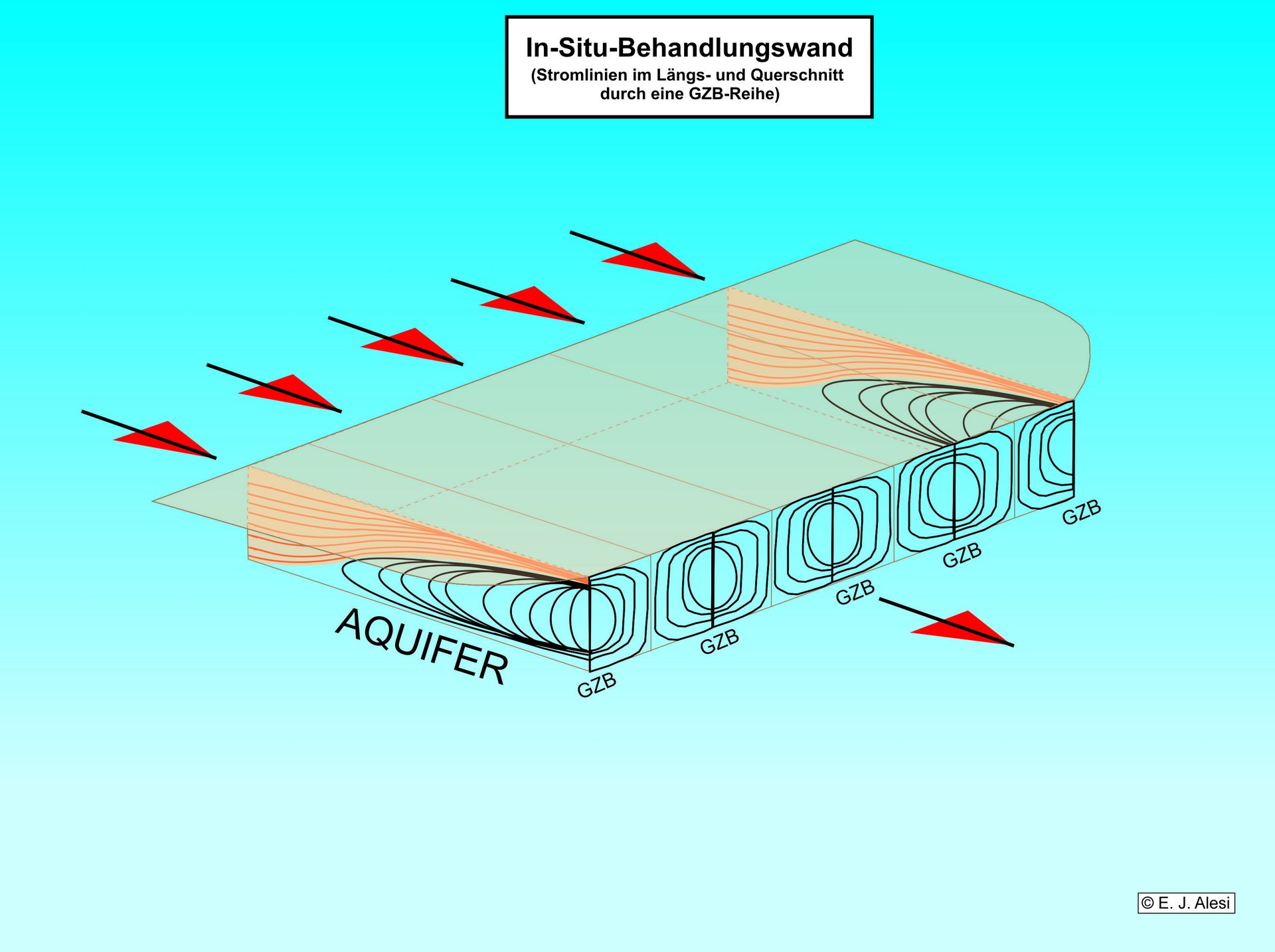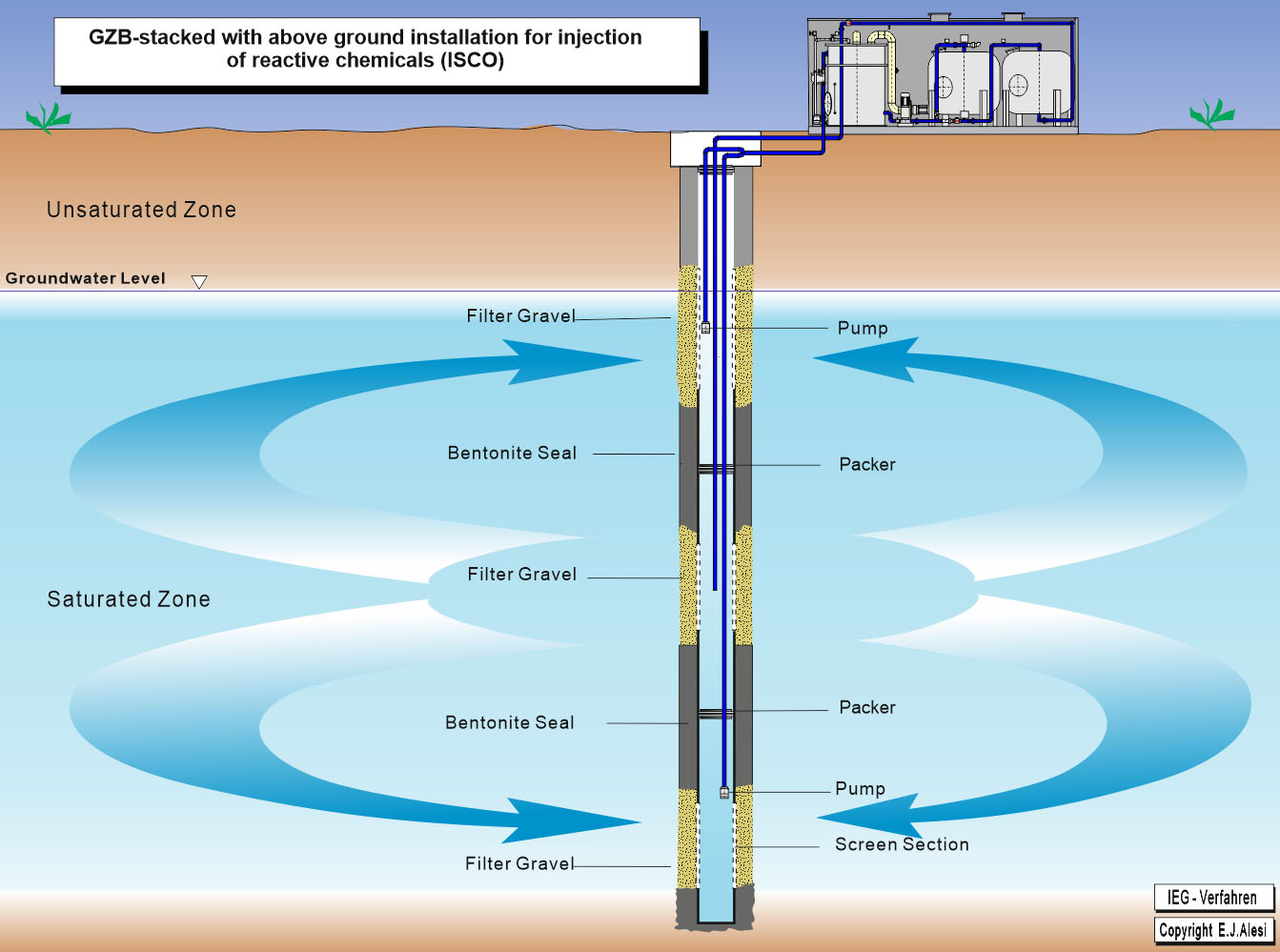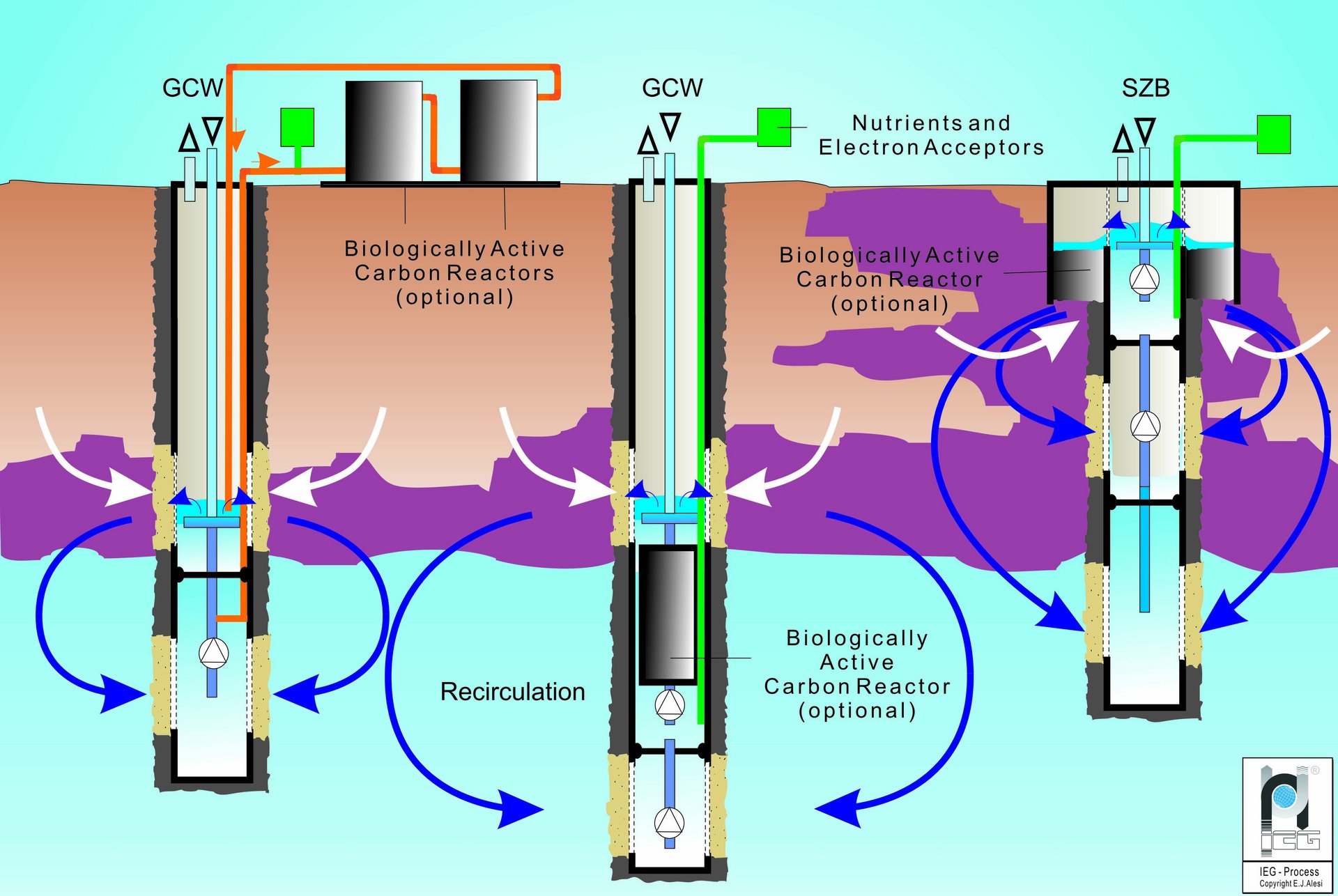Inducing a circulating flow field using a Groundwater Circulation Well (GCW)
With the conventional „Pump & Treat“ method, groundwater is extracted from pumping wells, treated above ground and disposed off to waste water or stormwater water sewers or surface waters. Even when extraction and injection wells are combined, predominantly higher permeable areas are preferentially penetrated and more fine-grained structures are by-passed. For aged contaminations the bulk of contaminants are adsorbed in the less permeable materials like fine - grained sands, silty or clayey layers. By diffusion, the contaminants are released out of these reservoirs extremely slowly. In such layered aquifers the time required to reach acceptable concentrations with traditional methods can be expressed in decades or even centuries.


Depending on subsoil conditions (geology and hydrogeology) and contaminant type and concentration, remediation of sites can take several decades. Consequently, „Pump & Treat“ technique is considered as being suitable and effective only for containment to prevent further spreading of contaminants, but is no longer considered as a remediation method.
With the „Pump & Treat“ method groundwater is radially extracted out of the aquifer. Due to a change in the hydraulic gradient, both contaminated and clean groundwater flows through the contaminated subsoil and is constantly treated above ground with considerable technical effort. GCW systems are designed to create in-situ vertical groundwater circulation cells by drawing groundwater from an aquifer through one screened section of a multi - screened well and discharging it back into the aquifer through another screened section. A circulation flow is generated in the aquifer and treated groundwater is circulated several times before it it is released out of the circulations downstream. This method of vertically flushing the aquifer guarantees a more efficient course of remediation and a significant reduction of expected remediation times compared with to „Pump & Treat“ method.
Possible Solutions
01
Coaxial Groundwater Circulation (CGC)
Coaxial Groundwater Circulation is a combined technique of soil air extraction and in-situ sparging. With this method, saturated and non-saturated zones are remediated simultaneously. Clean compressed air is injected into an air diffusor at the bottom of the well. The micro bubbles rise within the well, causing groundwater to flow upward between the lower and upper annular space of the well. In the capillary fringe area which is straddled by a double cased screen, air is extracted. Thus, groundwater is lifted from the bottom to the top of the well and adiabatic stripping takes place. Stripped groundwater flows back into the aquifer and circulates to the bottom of the well whereas the stripped VOCs travel with the extracted air to suitable active carbon filters.

02
Soil Circular Flushing Well (SZB)
Non-volatile contaminants in the unsaturated zone and in the groundwater fluctuation area can be removed by means of the soil flushing technique. Cleaned and possibly oxygen-enriched groundwater re-accesses the subsoil via drain pipes or vertical screen sections after passing a cleaning system (e.g. bio-reactor etc.). The oxygen saturation as a consequence of the stripping process supports microbiological decomposition in the subsoil. In case of high ground water fluctuations, the often highly -contaminated capillary fringe can be included in the remediation, combined with a GCW or a soil air extraction installation.
03
GCW Well Fields for the treatment
of large plumes or large-surface contamination areas
If the width of a plume is larger than the capture zone of a single GCW, several GCWs are arranged in one line perpendicular to natural groundwater flow. By means of multiple rows of GCW wells, source and plumes can be intensely remediated also in case of large areas. By changing the distance between the GCWs or well series, interaction between the GCWs, with predominantly horizontal flow directions, can also be achieved.

04
Accelerated biodegradation of contaminants
By means of different techniques oxygen, gas mixtures but also nutrient solutions can be added to the water circulated by the GCW. Thus, oxygen-enriched groundwater circulates through the aquifer and stimulates microbiological degradation creating better bioavailability. Metabolites impeding the growth of auto-chthonic micro organisms or the CO2 produced by the biological decomposition processes can be transported to the well with the groundwater and can be selectively removed there.
05
Active dispersing process for chemicals
Oxydating agents required for ISCO are prepared above ground and fed into the groundwater by adding the chemical in a controlled way to the recirculation flow. The required quantities should be determined by means of laboratory tests beforehand. Adding hydrogen peroxide in moderate concentrations will stimulate the aerobic biological degradation. The radial-symmetric circulation fields permit more homogenous and more effective dispersion of chemicals in the subsoil than injection techniques.

06
Simultaneous Free Product Recovery
Extraction of light and dense non aqueous phase liquids - GCW-LNAPL/DNAPL
The flow induced by a GCW can be used to accelerate the removal of non-miscible liquids of lower or higher density than water (LNAPL and DNAPL) from an aquifer. In order to remove light non aqueous liquids floating on the groundwater, the GCW is operated in a reverse mode. In order to remove dense non aqueous phase liquids (DNAPL) that have accumulated on the bottom of the aquifer, the GCW is operated in standard mode. The LNAPL or DNAPL is removed by means of a sensor-controlled, pneumatically- driven submersible pump. Thus it is made sure that just pure phase and no groundwater is extracted.
Potential Technological Advantages of IEG-GCW Technology
Current projects

Contact
Marcel Alesi
+49(0)7335 96976-0
hello@ieg-technology.com




